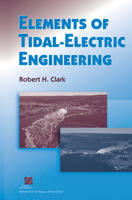
Elements of Tidal-Electric Engineering
Wiley-IEEE Press (Verlag)
978-0-470-10709-6 (ISBN)
The first text to cover all stages of a tidal-electric feasibility study
As interest in tidal-electric power generation continues to grow in response to demands for renewable sources of energy, readers can now turn to Elements of Tidal-Electric Engineering for the first comprehensive treatment of the subject. The author, Robert H. Clark, a leader in the field for almost fifty years, has spearheaded several important research projects and consulted with governments and private industries around the world on tidal-electric issues.
The focus of this text is the feasibility study. Power engineers gain both the knowledge and the skills needed to accurately determine the feasibility of a proposed tidal power development plan, including:
* Major factors to consider in selecting a site for preliminary assessment
* Tidal power schemes and mode
* Hydraulic and mathematical models of estuaries to predict the estuary's response to physical changes and the effects caused by operation of the proposed plant
* Civil works required for tidal power development and the associated tidal generating equipment
* Procedures to optimize plant output
* Economic evaluation and risk assessment
* Environmental impact of proposed construction and operation
The book ends with an examination of commercially operating plants and a brief review of sites that have been the subject of investigation in the last half century. References and bibliographies direct readers to primary source material for further study.
Until publication of this text, power engineers have had to rely on random journal articles and anecdotal information to perform a feasibility investigation. With the publication of Elements of Tidal-Electric Engineering these engineers have a single, integrated source that methodically covers all the issues.
ROBERT H. CLARK, OC, MENG, PENG, has been studying and working with tidal-electric power since the late 1950s, beginning with his work with the International Passamaquoddy Engineering Board. As chief hydraulic engineer with Canada's Department of Energy, Mines and Resources, he led the research into the viability of exploiting the Bay of Fundy's tidal resources. Mr. Clark has been appointed an Officer of the Order of Canada (OC).
Preface xi
Acknowledgments xv
1 Historical Development 1
2 Tidal Phenomenon 7
2.1 Introduction 7
2.2 Ocean Tides 8
2.3 Types of Tides 9
2.4 Propagation of Tides in Estuaries 12
2.5 Coriolis Effect 13
2.6 Barrage Effects 13
3 Tidal Power Potential and Site Selection 15
3.1 Hydroelectric Versus Tidal-Electric Developments 15
3.2 Site Potential Estimation 17
3.3 Coefficient of the Tide 19
3.4 Major Factors Influencing Project Economics 20
3.5 Site Selection 20
4 Management and Organization of Investigations 25
4.1 Management 25
4.2 Organization 28
4.3 Feasibility Studies 29
5 Tidal Power Schemes and Modes of Operation 35
5.1 Single-Basin Development, Single-Effect Mode of Operation 35
5.2 Single-Basin Development, Double-Effect Mode of Operation 38
5.3 Pumping to Augment Tidal-Effect 40
5.4 Linked-Basin Developments 42
5.5 Paired-Basin Developments 45
5.6 Retiming of Tidal Energy 45
6 Basic Data 47
6.1 Introduction 47
6.2 General Physiography of the Estuary 48
6.3 Geology 49
6.4 Tides 50
6.5 Waves 54
6.6 Tidal Currents 54
6.7 Suspended and Mobile Sediments 55
6.8 Ecosystem Characteristics 58
7 Hydraulic and Numerical Models in Feasibility Investigations 59
7.1 Introduction 59
7.2 Hydraulic Models 60
7.3 Numerical Models for Estuaries 62
7.4 Hybrid Models 67
7.5 Modeling of Barrier Effects 67
7.6 Mathematical Model for Closure Activities 69
7.7 Utility System Planning and Simulation 69
8 Civil Works for Tidal Power Development 71
8.1 Introduction 71
8.2 Dry Versus Wet Construction 72
8.3 Design Parameters 77
8.4 Caisson Design 80
8.5 Dikes 87
8.6 Construction Schedules 95
9 Electromechanical Equipment for a Tidal Plant 97
9.1 Introduction 97
9.2 Specific Requirements for Tidal Generating Equipment 98
9.3 Types of Turbines 99
9.4 Generators 113
9.5 Electrical Equipment 114
9.6 Transmission 115
10 Optimization of Plant Output 117
10.1 Principal Variables 117
10.2 Energy Production and Optimization 118
10.3 Simulation of Operation 120
10.4 Development of Models 121
10.5 Plant Optimization 124
11 Integration of Output with Electric Utility Systems 129
11.1 Introduction 129
11.2 Absorption of Raw Tidal Energy 132
11.3 Enhancing Raw Tidal Energy Output 137
11.4 System Considerations 141
12 Economic Evaluation 149
12.1 Introduction 149
12.2 Economic Cost Parameters 152
12.3 Economic Analysis 153
12.4 Sensitivity Analysis 155
12.5 Risk Assessment 157
13 Social and Regional Impacts 159
14 Environmental Aspects 165
14.1 Unique Effects 167
14.2 Agricultural Aspects 174
14.3 Floods and Drainage 175
14.4 Birds 176
14.5 Fish and Fisheries 177
14.6 Recreation and Tourism 178
14.7 Transportation 179
14.8 Summary 179
15 Existing Tidal-Electric Developments 183
15.1 La Rance Tidal-Electric Plant 184
15.2 Jiangxia Tidal-Electric Plant 194
15.3 Kislaya Guba Experimental Plant 195
15.4 Annapolis Tidal-Electric Plant 198
16 Potential Developments 207
16.1 Argentina 208
16.2 Australia 211
16.3 Brazil 214
16.4 Canada 215
16.5 Canada–United States 224
16.6 China 226
16.7 France 226
16.8 India 228
16.9 Korea 230
16.10 Mexico 233
16.11 Russian Federation 234
16.12 United Kingdom 238
16.13 United States 242
Appendix A: Tidal Generation Optimization Models 245
Glossary of Terms 255
References 263
Bibliography 275
Index 277
| Erscheint lt. Verlag | 17.4.2007 |
|---|---|
| Reihe/Serie | IEEE Press Series on Power and Energy Systems |
| Zusatzinfo | Charts: 82 B&W, 0 Color; Photos: 19 B&W, 0 Color; Maps: 31 B&W, 0 Color; Tables: 12 B&W, 0 Color |
| Sprache | englisch |
| Maße | 161 x 243 mm |
| Gewicht | 544 g |
| Themenwelt | Technik ► Elektrotechnik / Energietechnik |
| ISBN-10 | 0-470-10709-X / 047010709X |
| ISBN-13 | 978-0-470-10709-6 / 9780470107096 |
| Zustand | Neuware |
| Haben Sie eine Frage zum Produkt? |
aus dem Bereich


